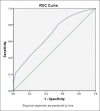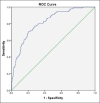Sternomental distance and sternomental displacement as predictors of difficult laryngoscopy and intubation in adult patients
- PMID: 28757825
- PMCID: PMC5516487
- DOI: 10.4103/1658-354X.206798
Sternomental distance and sternomental displacement as predictors of difficult laryngoscopy and intubation in adult patients
Abstract
Background: Several morphometric airway measurements have been used to predict difficult laryngoscopy (DL). This study evaluated sternomental distance (SMD) and sternomental displacement (SMDD, difference between SMD measured in neutral and extended head position), as predictors of DL and difficult intubation (DI).
Materials and methods: We studied 610 adult patients scheduled to receive general anesthesia with tracheal intubation. SMD, SMDD, physical, and airway characteristics were measured. DL (Cormack-Lehane grade 3/4) and DI (assessed by Intubation Difficulty Scale) were evaluated. The optimal cut-off points for SMD and SMDD were identified by using receiver operating characteristic (ROC) analysis. Multivariate logistic regression was used to predict DL and ROC curve was used to assess accuracy on developed regression model.
Results: The incidence of DL and DI was 15.4% and 8.3%, respectively. The cut-off values for SMD and SMDD were ≤14.75 cm (sensitivity 66%, specificity 60%) and ≤5.25 cm (sensitivity 70%, specificity 53%), respectively, for predicting DL. The area under the curve (AUC) with 95% confidence interval (CI) for SMD was 0.66 (0.60-0.72) and that for SMDD was 0.687 (0.63-0.74). Multivariate analysis with logistic regression identified inter-incisor distance, neck movement <80°, SMD, SMDD, short neck and history of snoring as predictors and the predictive model so obtained exhibited a higher diagnostic accuracy (AUC: 0.82; 95% CI 0.77-0.86). SMDD, but not SMD, correlated with DI.
Conclusions: Both SMD and SMDD provide a rapid, simple, objective test that may help identifying patients at risk of DL. Their predictive value improves considerably when combined with the other predictors identified by logistic regression.
Keywords: Anesthetic techniques; anthropometry; difficult; intubation tracheal; laryngoscopy.
Conflict of interest statement
There are no conflicts of interest.
Figures
References
-
- Al Ramadhani S, Mohamed LA, Rocke DA, Gouws E. Sternomental distance as the sole predictor of difficult laryngoscopy in obstetric anaesthesia. Br J Anaesth. 1996;77:312–6. - PubMed
-
- Savva D. Prediction of difficult tracheal intubation. Br J Anaesth. 1994;73:149–53. - PubMed
-
- Allahyary E, Ghaemei SR, Azemati S. Comparison of six methods for predicting difficult intubation in obstetric patients. Iran Red Crescent Med J. 2008;10:194–201.
-
- Merah NA, Foulkes-Crabbe DJ, Kushimo OT, Ajayi PA. Prediction of difficult laryngoscopy in a population of Nigerian obstetric patients. West Afr J Med. 2004;23:38–41. - PubMed
LinkOut - more resources
Full Text Sources
Other Literature Sources
Medical



